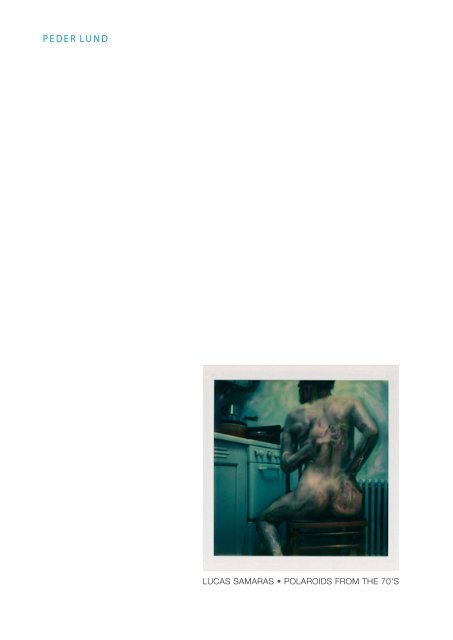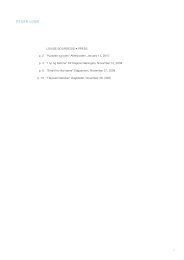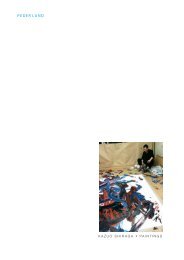LUCAS SAMARAS • POLAROIDS FROM THE 70'S
LUCAS SAMARAS • POLAROIDS FROM THE 70'S
LUCAS SAMARAS • POLAROIDS FROM THE 70'S
Create successful ePaper yourself
Turn your PDF publications into a flip-book with our unique Google optimized e-Paper software.
PederLund_Logo_oktober_finale 30.10.2009 11:44 Uhr Seite 1<br />
Probedruck<br />
C M Y CM MY CY CMY K<br />
<strong>LUCAS</strong> <strong>SAMARAS</strong> <strong>•</strong> <strong>POLAROIDS</strong> <strong>FROM</strong> <strong>THE</strong> <strong>70'S</strong>
<strong>LUCAS</strong> <strong>SAMARAS</strong><br />
Peder Lund has the pleasure of welcoming you to the exhibition Lucas Samaras: Polaroids<br />
from the 70s. The exhibition shows a selection of central works from Samaras’<br />
Polaroids from the 1970s in which Samaras himself is the subject matter, photographed<br />
in his studio and home.<br />
Samaras began using a Polaroid 360 camera in 1969, which gave rise to the series<br />
Auto-Polaroid. In 1973, the Polaroid Corporation gave him an SX-70 camera, which<br />
he used in his subsequent exploration of the medium, during which he further manipulated<br />
his motifs. Such manipulation is especially pronounced in the series Photo-<br />
Transformations.<br />
Despite the artist’s central standing, consolidated by many purchases by and exhibitions<br />
at major museums around the world, the work of Lucas Samaras has never before<br />
been shown in Norway. The exhibition at Peder Lund therefore provides a unique<br />
insight into Samaras’ art, hitherto inaccessible to the Norwegian public.<br />
Lucas Samaras was born in Kastorias, Macedonia in Greece in 1936. He moved to the<br />
USA in 1948, at the age of twelve. He studied art at Rutgers University from 1955 to<br />
1959. While he was there, he met Allan Kaprow, George Segal and Robert Whitman,<br />
all pioneers of happenings and performance art. Samaras is a multi-media artist who<br />
has worked with most media. What unifies his work is his enduring personal awareness,<br />
both physical and psychological. It is this that forms the central thread running<br />
through his work. Samaras’ art is hard to describe and categorise, although the art<br />
historian Matthew Naigell has characterised Samaras using words such as “archetypal<br />
post-Dadaist, post-surrealist, and post Abstract-Expressionist.”<br />
Lucas Samaras’ photographic self-portraits made use of, what was at the time, the<br />
new Polaroid technique, which appealed to him both for its intimacy – it is highly<br />
suitable for private, self-reflective images in a domestic setting – and for its chemical<br />
properties. The chemical properties enables him speedily develop a picture that can be<br />
manipulated and embellished with a painterly quality before the photosensitive material<br />
hardens and is fixed. The resulting self-portraits are narcissistic, in that they offer the<br />
artist the possibility to view the results of his grimaces and posturings almost immediately.<br />
The new technique is so rapid that it can be compared with grooming oneself<br />
in front of a mirror. In this sense these are captured mirror images. No less significant<br />
is it that these pictures were produced in a context in which performance art, with its<br />
interest in boundaries and its explorations with body language, was crucial to the neoavant-garde’s<br />
activities. Exploration of the artist’s own body and facial expressions<br />
did in addition become an important theme in the new medium of video art in the late<br />
1960s. Parallels to Samaras’ performative self-portraits are found in contemporary<br />
video works by artists such as Robert Morris, Hannah Wilke, Joan Jonas, Bruce Nauman<br />
and Dan Graham, to name but a few of the most important.<br />
Lucas Samaras works in a neo-Dada or neo-avant-garde tradition. His photo-transformations<br />
constitute a topical exploration of the classical avant-garde’s themes and<br />
expressions, formulated in the new media of his day. The neo-avant-garde set out to<br />
reaffirm, reorient and explore afresh many of the radical expressions and processes<br />
that changed the course of art from Gustave Courbet onwards, and which were further<br />
pursued in symbolism, expressionism, Dada and surrealism. It is this tradition Samaras<br />
continues, rather than the formalistic, which is traced through Paul Cézanne and cubism<br />
and, which led to constructivist sculpture and abstract painting.<br />
2
Samaras’ Polaroids from the 1970s are indebted to a deep romantic impulse. The classic<br />
works art of the avant-gardes are clear forerunners and models, which Samaras<br />
interprets anew and brings up to date in this work. His Photo-Transformations are<br />
concerned with themes that were utterly central to art in the latter half of the 19th–<br />
and the first decades of the 20th century, namely the male artist’s self-portrait, more<br />
broadly – the male nude, and generally, the naked self-portrait. The depiction of naked<br />
men has dominated many important periods of art history, such as Greek and Roman<br />
antiquity, when the healthy, well-trained male body – the sportsman and the warrior –<br />
was idealised as the ultimate example of beauty and noble form. This idealised view<br />
of male nudity was revived during the renaissance. But during the 19th century – with<br />
the growth of modern, bourgeois society – a crisis in relation to the artistic depiction<br />
of nakedness occurred. This was partly true of the female body, 1 but particularly so of<br />
the male body. Art historian Petra ten-Doesschate Chu has called this “the ‘crisis’ of<br />
the male nude.”<br />
It was the avant-garde that returned to this problem and broke down the boundaries of<br />
propriety and social taboo. Gustave Courbet (1819–77) was the first artist to persistently<br />
paint challenging nudes of contemporary women. And it was Courbet who picked<br />
up the thread from Rembrandt, applying a personal, critical, and ruthlessly analytic<br />
gaze on the artist’s self-portraits. Of greatest significance for Samaras’ self-portraits<br />
are Courbet’s depictions of himself in melodramatic poses, 2 such as the paintings Man<br />
Mad with Fear (1843) and The Desperate Man (1843), in which his face is distorted and<br />
his body has lost its footing and is falling, physically out of balance due to psychological<br />
tension. This trend was pursued further by some of the post-impressionists and<br />
symbolists, most notably van Gogh and Edvard Munch; and following them, by the<br />
German expressionists, among whom it was Karl Schmidt-Rottluff who came closest<br />
to Munch and van Gogh in intensity. 3<br />
1 In the 19th century the female nude was celebrated in the form of goddesses, odalisques and allegorical figures. Prostitutes<br />
and so-called “cocottes” could also be also depicted in minimal attire, but were a cause of controversy and scandal, as for<br />
example Eduard Manet’s Olympia from 1863.<br />
2 Courbet’s many romantic self-portraits are interesting in forging a new, free and independent role for the artist, although less<br />
relevant to an understanding of Samaras’ art.<br />
3 In the field of neo-expressionist painting, this type of portrait and self-portrait art attained particular prominence among English<br />
painters in the 1950s and 60s, such as Francis Bacon, Frank Auerbach and Leon Kossoff.<br />
3
Lucas Samaras’ Polaroid self-portraits are given a painterly treatment, and it is the<br />
coarse distortions, the brutal physicality and the shattered aspects of pictures such as<br />
Munch’s Self-Portrait in Hell (1903), van Gogh’s Self-Portrait with Bandaged Ear (1888)<br />
as well as Schmidt-Rottluff’s Self-Portrait from 1906, with its coruscating colours, that<br />
we see echoed in Samaras’ work. Like the artists of some 70 years earlier, the distorted,<br />
decomposed aspect of the facial expression, and the manner of depicting it,<br />
constitute an image, or a symbol, of an internal conflict, anxiety, or a disjointed and<br />
chaotic psychological condition.<br />
In some of his pictures, Samaras plays with typical neo-avant-garde situations, such<br />
as the kitchen scenes of low budget social-realist films (a typology exploited by Cindy<br />
Sherman in some of her film stills, and by Bill Viola in some of his early videos), film noir<br />
devices, such as the shadow of a Venetian blind across a face and its background, or<br />
more romantic, film-inspired scenes, in which someone stares dreamily up at a plant or<br />
a tree with a strong backlight framing the silhouette-like figure.<br />
But what makes some of the photo-transformations particularly evocative is the combination<br />
of the naked body and stylised hand movements. These are marked, vulnerable<br />
bodies, decaying, covered in rashes or scars, or bodies wrapped in yarn, or hidden behind<br />
a woven cloth so that the head and body are buried and almost concealed. These<br />
images disrupt our notion of the pure, harmonic and balanced body. There is an ardent,<br />
almost electrical force that makes some of the pictures seem as if a sacred light or<br />
aura emanate from the body. They bring to mind Walt Whitman, who in one of his most<br />
potent metaphors compared the body’s nervous system, and its lustful observation of<br />
the bodies of others, with electrical currents. In the poem “I Sing the Body Electric,”<br />
originally published in the first edition of the celebrated collection of poems, Leaves of<br />
Grass, from 1855, Whitman sings the song of the male- and the female body:<br />
”…You linger to see his back and the back of his neck and/shoulderside. / The sprawl<br />
and fullness of babes …. the bosoms and heads of/women (…) The swimmer naked<br />
in the swimmingbath …. Seen as he swims/through the salt transparent greenshine (…)<br />
4
In some of Samaras’ works as well, the bodily references are rendered erotic. The artist<br />
of the classical avant-garde who stands out as the clearest forerunner of Samaras’<br />
photo transformations is Egon Schiele (1890–1918). It was Schiele who confronted the<br />
crisis of the male nude with the greatest forthrightness, as in the picture of himself masturbating,<br />
a generalised “masculine” figure with an enormous bright red erection in the<br />
picture Eros from 1911, or the frightening self-portrait in which he depicts himself as a<br />
mutilated, bestial hermaphrodite, with footless legs and the body hair of a satyr. In this<br />
sensationally scandalous picture – with the title Seated Male Nude (Self-Portrait), from<br />
1910 – Schiele has portrayed himself as utterly consumed by sexual urges. The sexual<br />
organs, the navel, the nipples and the eyes are all bright red, as if these organs and<br />
erogenous zones were aflame with desire; as if the body had been hollowed out and a<br />
powerful red electric light placed inside it. That everything is governed by natural urges<br />
is reflected in the way the figure floats in the pictorial space, utterly detached from social<br />
hierarchies and anything that might keep him physically anchored to the ground. 4<br />
Like several other avant-garde artists, Samaras suffers not only from acute narcissism, 5<br />
he also has a familiar penchant for identifying with martyrs. Art is something that is created<br />
through major personal sacrifices and physical suffering. The body is stigmatised<br />
with society’s hostile nail marks resulting from social crucifixion. In one of his pictures,<br />
he assumes the role of St. Sebastian pierced with arrows, an explicit echo of Schiele’s<br />
motif on the same theme in his poster for the exhibition at Galerie Arnot in 1914–15,<br />
Self-Portrait as St. Sebastian.<br />
Egon Schiele is also significant when it comes to Samaras’ photographic staged selfportraits,<br />
which have played an important role in his career since the 1970s. In one<br />
series of photographs, Samaras performs a kind of pantomime, where he – as in some<br />
of the painted self-portraits – not only pull faces, but also makes figures and signs with<br />
his hands. 6<br />
4 Bjarne Melgaard’s The Lightbulb Man (1996) is a treatment of the same issue and vision.<br />
5 In Norway and Sweden, Kjartan Slettemark is the artist who resembles Samaras most closely in the use of his own body as a<br />
motif.<br />
6 In 1914, the photographer Anton Josef Trcka took stylised photos of Schiele, for example Egon Schiele with Raised Arms and<br />
Egon Schiele Forming a Figure with his Hands.<br />
5
The combination of vulnerable nakedness, intense erotic drive, psychological instability<br />
and physical suffering, with elements of bindings and bondage, is a feature of Samaras’<br />
photo-transformations that offer clear references to the contemporaneous Vienna<br />
Actionists. In one of these, the screen in front of the face resembles gauze bandages,<br />
à la Rudolf Schwarzkogler, and the open, screaming mouth – visible through the hole<br />
in the cloth – flashes its teeth like a mad dog. This constitutes an artistic homage to<br />
Francis Bacon’s famous pope painting of 1953, based on Velazquez’ Pope Innocent<br />
X; the scene on the steps in Odessa from Sergei Eisenstein’s Battleship Potempkin<br />
(1925); Munch’s Scream (1893); and Willem de Kooning’s Woman series. The edges of<br />
the orifice and the potentially erotic zone are here rendered dangerous by the castrating<br />
set of teeth. This work is firmly rooted in the history of the avant-garde, and yet it is<br />
a remarkably original, simple and condensed expression of a terrifying archetype that<br />
men carry deep in their unconscious. Moreover, Samaras avoids the fetishist version of<br />
this motif, as does Nancy Grossman around the same time.<br />
The strongly expressionist self-portraits must be seen in conjunction with Samaras’<br />
mirror cabinets. The forerunner for the mirror installations on which he worked alongside<br />
Yayio Kusama and Dan Graham, was probably Kurt Schwitters’ Merzbau (1923,<br />
1937, 1947), a bizarre psycho-spatial apparatus, which Schwitters saw as expressing<br />
erotic wretchedness. Samaras’ mirror installations are as confusing and fragmenting<br />
as a kaleidoscope. This type of spatial organisation reflects the image of a divided self;<br />
someone who is unstable in relation to his spatial surroundings and in all likelihood<br />
also in terms of what psychoanalysis refers to as “object relations.” The frightening<br />
and expressive keynote in all this is the insistence that the price we pay for modern,<br />
urban, sexually emancipated and norm-transgressing narcissism is fragmentation. In<br />
the original myth, Narcissus’ punishment was to be frozen in his own mirror image;<br />
in the modern world, with its noisy metropolises, its horrors of electric bombardment<br />
and its pornographic scenario of total exposure, the punishment comes in the form of<br />
instability and insufficient orientational routines in the gap between desire and pain,<br />
harmony and dissonance. It is Samaras’ precise articulation of this disquiet that makes<br />
his art so vital.<br />
Subjects 1969–1986” (1988–89). In 1983, the International Polaroid Collection in Cambridge<br />
arranged the exhibition “Polaroid Photographs 1969–1983,” which opened at<br />
the Centre Pompidou in Paris before transferring to the International Center of Photography<br />
in New York and the Serpentine Gallery in London. Eight years later, the Yokohama<br />
Museum of Art organised the exhibition “Lucas Samaras – Self: 1961–1991,”<br />
which was also shown at Hiroshima City Museum of Contemporary Art. In 2003–2004,<br />
the exhibition “Unrepentant Ego: The Self-Portraits of Lucas Samaras” was shown at<br />
the Whitney Museum of American Art in New York, and the exhibition “Lucas Samaras”<br />
at the National Museum in Athens in 2005. In 2009 a solo exhibition with Samaras’ art<br />
was shown at the 53rd Venice Biennale.<br />
Samaras’ works have been purchased by major institutions including: the Art Institute<br />
of Chicago; High Museum of Art, Atlanta; Hirshhorn Museum and Sculpture Garden,<br />
Washington D.C.; Los Angeles County Museum of Art, LA; Metropolitan Museum of<br />
Art, New York; Museum of Modern Art, New York; Walker Art Center, Minneapolis;<br />
Whitney Museum of American Art, New York; Tate Gallery, London; Australian National<br />
Gallery, Canberra; Hara Museum of Contemporary Art, Tokyo.<br />
6
LIST OF ILLUSTRATIONS<br />
s. 1<br />
s. 2<br />
s. 3<br />
s. 4<br />
s. 5<br />
s. 6<br />
Lucas Samaras, Photo-Transformation 6/14/74, Polaroid SX-70 photograph<br />
Lucas Samaras, Auto-Polaroid, 1969-71, Polaroid photograph<br />
Lucas Samaras, Photo-Transformation 11/6/73, Polaroid SX-70 photograph<br />
Lucas Samaras, Photo-Transformation 10/27/73, Polaroid SX-70 photograph<br />
Gustav Courbet, Den desperate mann, 1844–45, oil on canvas<br />
Lucas Samaras, Auto-Polaroid, 1969-71 (Part 1), Polaroid photograph<br />
Lucas Samaras, Auto-Polaroid, 1969-71, Polaroid photograph<br />
Lucas Samaras, Photo-Transformation 7/16/73, Polaroid SX-70 photograph<br />
Lucas Samaras, Auto-Polaroid, 1969-71, Polaroid photograph<br />
Anton Josef Trcka, Egon Schiele, 1913, photograph<br />
Lucas Samaras, Photo-Transformation 12/20/73, Polaroid SX-70 photograph<br />
Francis Bacon, Head VI, 1949, oil on canvas<br />
The text is written by Åsmund Thorkildsen, Director at Drammen Art and Culture<br />
Museum.<br />
7









